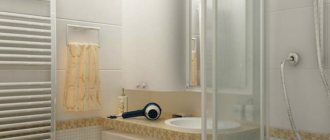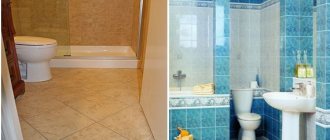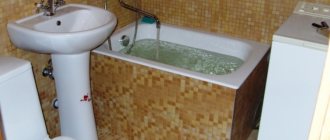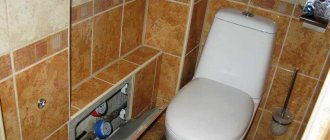Cork flooring in the bathroom has a number of advantages and calls into question the lack of alternative to the use of ceramic tiles for finishing the floor and walls in the bathroom. The warm surface is very comfortable to the touch; no heating system is required. After installation and protective treatment, adhesive floor coverings turn into a waterproof monolith that can be watered and used at any humidity or temperature!
For finishing a bathroom, adhesive cork flooring and wall plates are suitable. We do not recommend using a locking plug: the HDF middle layer does not tolerate humidity or regular contact with water.
Types of cork floors and their features
There are two types of cork flooring available on the market:
- Cork parquet. This material also has other common names - locking plug, floating floor. The covering in the form of a locking plug is a slab, similar in size to parquet or laminate. Here, the veneered cork is glued to a gasket in the form of an HDF board, which behaves poorly in excess moisture: it can swell, deform or crack. For this reason, cork parquet is not recommended for use in bathrooms and other rooms with high humidity and frequently changing air temperatures.
- Glue plug. This type of flooring consists only of agglomerate and cork veneer. The raw materials are subjected to high-temperature processing and pressing, resulting in durable and environmentally resistant adhesive boards in the form of squares or rectangles. They are mounted with a special glue, after which the cork floor in the bathroom must be covered with several layers of protective varnish. A properly installed and protected coating tolerates high temperatures well and is not afraid of moisture, so it can serve as a cork floor in the bathroom for a long time.
What is a cork and where does it come from ↑
This is a material of natural origin. It is obtained from the bark of the cork oak tree. The plant has the natural property of peeling off its bark once every few years. In order not to harm the trees and to obtain high-quality raw materials, the bark is removed no more than once every 6-7 years, or even less often, starting from the age of 25 years. Such conditions contribute to the longevity of trees; on average, they live up to 170-180 years. The best is considered to be the bark of oak, which “celebrated” its 150th anniversary. On average, about 200 kilograms of cork are obtained from one tree. The largest habitat of the cork oak is in European countries such as France, Spain, Italy and Portugal. Cork flooring is produced primarily in these countries.
Cork tree bark
Performance advantages of cork coatings
Cork flooring has a number of advantages compared to other common types of flooring. Most of them received cork material due to its porous structure, since veneered cork consists of more than half air. A special technology for the production of cork coverings is also important, in which adhesives and other compositions based on chemical components are not used.
The main advantages of cork floors:
- Environmental friendliness and health benefits. There are no components harmful to health in the composition of cork floors; the floor itself does not emit foreign fumes during installation and operation. Due to its naturalness, cork is recognized as a hypoallergenic material.
- Cork flooring absorbs well, so it is not only comfortable to walk on, but useful: due to the springing of the cork, the load on the musculoskeletal system is reduced.
- This coating absorbs sound well, so you can save on additional soundproofing material.
- Cork does not absorb heat or conduct it, so such floors always seem warm, even if they are laid on cold concrete.
- Cork flooring is easy to care for: regular wet cleaning is enough. If necessary, the plug can be cleaned with a vacuum cleaner.
- After mechanical deformation, the material quickly returns to its original shape. If the damage to the floor is severe enough and the surface of the cork covering is slightly damaged, the defect can be repaired with technical granulated cork.
- Cork flooring is durable when properly installed and maintained. Manufacturers usually provide a guarantee for such flooring for more than 10 years.
- You can install cork flooring yourself: you don’t need professional equipment or tools for this.
Despite all its positive performance characteristics, cork flooring complies with all environmental standards.
Types of finishing materials
The modern range of finishing materials for wall surfaces in the bathroom is amazing. Along with the usual paints and tiles, many alternative coatings have appeared, with which you can turn the bathroom not only into the most practical room, but also make it uniquely attractive.
Ceramic wall coverings
Ceramic tile elements. Traditional tiles are a classic way to decorate a bathroom. The choice of color shades, sizes and textured surfaces is very large. To decorate ordinary panels, there are borders, inserts, and panels, thanks to which any tile composition can be made individual.
This ceramic material has a number of advantages:
- long service life - even under harsh conditions, tile panels will last for several decades;
- hygienic properties of the material - dirt particles do not linger on the ceramics, it is quite easy to clean;
- decorative qualities - choosing any color and texture today is quite simple in a huge assortment.
But the tile material also has a minus. It lies in the fact that the cost of the layout and the tile itself is high. In addition, this will require a lot of time and the involvement of professional craftsmen. Yes, and the vaunted durability is a minus, since tastes and fashion trends change, but the tiles will still remain in place unchanged.
Installation of tile work begins only after preparing the wall surfaces. The walls are plastered with special compounds with increased moisture resistance. After this, a primer is applied. When all the preparatory layers have dried, they begin to lay the tile panels on a moisture-resistant adhesive base. Level control is carried out throughout the entire display period, otherwise any flaws and shortcomings will be noticeable.
Porcelain stoneware materials are worthy competitors to traditional tiles. Porcelain stoneware is distinguished by its strength and durability. In addition, it perfectly imitates natural stone. This is an environmentally friendly, safe product on which various microorganisms cannot reproduce and live.
The main disadvantage of porcelain stoneware is its high cost.
Plastic for wall coverings
Plastic modules are one of the most versatile and suitable materials for the bathroom. The plastic panel is very popular among ordinary people, as it can withstand high humidity levels, temperature changes, does not lose its color and can withstand loads. The undeniable advantages of working with plastic are quick and simple installation procedures, in which there is virtually no dirt and dust. Anyone can decorate walls with such panels independently, without the involvement of qualified workers.
Installation manipulations take place in several stages:
- remove old coating and remove debris;
- to avoid the formation of fungus and mold, the walls are treated with antiseptic compounds;
- install lathing from profiles of metal or plastic origin. Constructions made of wood that has been pre-treated with moisture-repellent solutions are also acceptable;
- installation begins by installing a starting corner in the corner of the room;
- each new panel is installed, the fastening narrow shelf fits into the previous groove, while the wide one is fastened with self-tapping screws. If there are installation profiles, fastening is carried out with clips. This option is much more convenient and faster.
Plastic panels are produced with different textures. The color palette of the material is very diverse. Therefore, with their help you can reproduce real designer masterpieces. It is possible to arrange the panels both horizontally and vertically, alternating shades or textures. The layout of the panels diagonally looks very stylish.
Benefits of a bathroom stopper
The use of cork flooring in bathrooms is advisable due to its heat non-conducting properties. At any temperature in the room, a cork floor will seem warm due to the fact that the cork does not conduct cold from the concrete screed or other rough covering, but at the same time does not take away the heat of the room. Therefore, walking on the cork floor in the bathroom is always comfortable and warm. In addition, in a room with a cork floor, you can refuse to install a “warm floor” system. The cork will still not heat up from it, but at the same time it will be warm due to its original properties.
Cork floors in the bathroom began to be used not so long ago, but have already established themselves as an excellent moisture-resistant material. But this statement applies only to adhesive cork, since the locking cork is more vulnerable to water. If the adhesive cork floor is correctly installed and protected with a special varnish, it does not care about temperature changes and high humidity.
Experts recommend installing cork floors in the bathroom because of their distinctive feature - cork does not slip and absorbs well. That is, on such a surface, even if it is wet, it is impossible to slip. But even if someone accidentally falls in a bathroom with such a coating, he will not receive injury, since the floor has good springs and, accordingly, the load on the injured area is significantly reduced when falling.
The peculiarity of choosing a floor covering for a bathroom is the need to protect the room from mold and bacteria, for which places with high humidity are an ideal place for their active reproduction. Cork is unsuitable for the life of such organisms, so even with constant humidity in the bathroom, they will not harm the floor covering.
Preparing for wall decoration
When asking the question of how to carry out any manipulations to finish wall surfaces in the bathroom, you should take into account and evaluate the following indicators:
Condition of wall surfaces
They should be completely even. However, this indicator will depend on what material is chosen for further finishing. If you plan to use paint or smooth materials in rolls as a coating, then there should not be the slightest unevenness on the wall surface. In the case of using tile or plastic panels, minor irregularities will not in any way affect the quality of the repair work.
Elements of old finishing on surfaces
If there is a coating of old tiles, it must be removed, and the remaining adhesive composition must be thoroughly cleaned. This process is quite labor-intensive and time-consuming. If there is a paint coating, it is permissible to leave it. Depending on the new material, it may be necessary to prime the walls. Putty and tile panels do not adhere well to oil paint. Plaster is not suitable for smooth concrete. The fastest way to prepare the surface so that the materials have good adhesion is to coat the wall with a primer.
To protect the walls of the bathroom from the proliferation and formation of fungal plaques, they should be treated with antiseptic compounds.
Aesthetic advantages of the material
Cork floors are widely valued by designers for their aesthetic features: veneered cork allows you to recreate unique natural patterns, combine different colors, and additional inserts. Therefore, manufacturers annually offer consumers a variety of collections to suit every taste.
When planning to install a cork floor in the bathroom, you can choose options with different decor and textures; the surface of cork floors is often complemented with leather elements, veneer of valuable wood species; there is the possibility of color photo printing on cork floors, which allows you to bring any design idea to life.
Selecting a semi-automatic system
The semi-automatic version of the water drainage device has been used since the beginning of the new millennium. It is used for a hole located on the side of the bathtub; it is used to remove excess water.
The operation of the auto device consists of several stages:
- The lever on the overflow is being installed.
- Connect the overflow and the tube of the drain structure, followed by installing the plug.
- The lever turns, setting the structure in motion.
In addition to the lever, you can install a rotary ring, button, decorative valve or handle. The convenience of the design lies in the absence of the need to tilt or lower your hand into the water. But such a system also has negative aspects. After 3 years, the structure jams, so the drain closes unreliably.
Cons of cork flooring
With all its advantages, there are some nuances that should definitely be taken into account before the process of purchasing and installing cork flooring. The disadvantages of this coating are:
- The high final cost of the cork floor, consumables and installation work if a specialist is involved.
- Unresistant to sharp objects. Walking in heels, falling sharp objects, and other similar impacts can damage the cork floor in the bathroom.
- Cork flooring requires several layers of protective varnish, otherwise it will not be resistant to moisture and temperature changes.
- Assembly adhesive and varnish for covering cork floors have a strong odor, which makes the process of laying the floor a little more difficult, but this is the responsibility of the installer.
- The adhesive plug is demanding of the base: it must be strong, perfectly smooth and clean. Therefore, it is worth adding the cost of the subfloor to the total costs. If this requirement is not met, cork floors in bathrooms quickly lose their properties and original appearance.
Drywall for finishing the bathroom
Plasterboard for finishing walls instead of tiles in a room that cannot boast of large dimensions is not the best choice. They are used instead of tiles when it is necessary to level out curved surfaces or, conversely, to create a special design - niches, curves, multi-layering.
In this case, for a room in which there is always high humidity, you only need to choose special sheets - moisture-resistant or cement-containing. They can be easily distinguished from others by their green color.
Benefits of drywall
The advantages of drywall are that it is convenient to attach, it is light in weight, and affordable. In addition, it maintains a favorable microclimate in the bathroom and has high soundproofing properties.
Flaws
Drywall cannot be left in this form - the surface must be decorated, it must be painted or covered with other materials - wallpaper, for example. The need to wait a couple of days after installing plasterboard sheets for them to completely “shrink” into place and additional putty and priming prolongs the repair period.
How to extend the life of a cork floor in the bathroom
It's no secret that natural wood materials are afraid of moisture, which is always present in the bathroom. Therefore, with all its advantages and production features, cork requires additional care and protection, as well as features in the choice of material:
- When choosing a cork flooring, preference should be given to adhesive cork - it is not afraid of moisture and is ideal for the bathroom.
- After installing the cork floor, it is necessary to apply several layers of protective varnish or vinyl to its surface.
- When laying cork slabs, you need to ensure that there are no joints between them, slabs and walls, plumbing fixtures and furniture.
- Every 3 years, renew the protective varnish layer of the floor - this will not only protect against moisture, but also preserve the original appearance of the cork covering.
- Clean cork floors using a damp cloth and a non-abrasive detergent.
If you follow all the recommendations listed, a cork floor will last even in a bathroom for more than 10 years.
Subtleties of cork making
The largest volume of cork is produced in Portugal from cork oak, where its plantings extend over 2.5 million hectares. The tree bark becomes suitable for removal only after 25 years of oak growth. In addition to this country, cork is produced in Algeria, Tunisia, Spain, France, Morocco and others.
Cork production is carried out without cutting down the tree: the bark is removed manually or using devices, and after 7 years the tree completely restores the integrity of the cover. The raw materials are crushed to obtain crumbs. Then it is pressed under pressure under high temperatures.
Features of installing cork flooring in the bathroom
In order for the cork floor in the bathroom to serve for a long time and delight you with its appearance and useful properties, you need to take a responsible approach to its installation. Adhesive cork requires careful preparation of the base: the old covering must be dismantled and a concrete screed made - this is an ideal subfloor for cork covering. Installation of adhesive boards is carried out from the center of the room. First you need to draw two axial perpendicular lines through the center of the room and, focusing on them, lay out the tiles, taking into account the following features:
- there should be a gap of 10 mm between the tiles and the walls;
- after cutting the cork tiles near the walls, their width and length should remain more than 5 cm.
Having laid out the cork tiles and made sure that the masonry meets the requirements, you can begin installing them from the middle of the room. To do this, use a special glue for cork floors, which is applied immediately to an area of approximately 2-3 square meters. After 15 minutes, you can start gluing the slabs, but it is worth considering the fact that the cork is instantly fixed and it is no longer possible to correct its position. Incorrectly glued elements are dismantled and cleaned.
After installing the floor, you need to cover the gaps between the slabs and the walls with plinths, and then seal them with sealant. This will prevent water from flowing around the edges of the room. When the entire floor is covered with tiles, it needs to be coated with 2-3 layers of special varnish for cork.
Non-standard finishing methods
- Self-adhesive film sheets are non-standard methods of wall decoration. The film does not allow water to pass through, and the butt seams are sealed with sealant. The advantages of the coating are the low price and a large selection of patterns and colors. However, upon closer inspection of the surface on which the film is applied, it becomes clear that this is a cheap way to replace more expensive coatings;
- Decorating the walls in the bathroom with tiles and photo printing will look non-standard and unique;
Linoleum for wall surfaces is a completely new type of covering, which is currently produced only by one company, TARKETT. Initially, these materials were developed for covering walls in medical institutions. Therefore, these are very reliable coatings that are resistant to water and chemicals. Their appearance resembles flexible plastic, the thickness of which is only 1 millimeter. Rolls of linoleum are two meters wide. The canvas is cut with scissors.
Installation of canvases is carried out on a flat surface. The sheets are fastened together by welding using a soldering iron with an adhesive cord.
An expensive but very attractive option is to decorate the walls with natural stone. The slabs have an impressive weight and arbitrary shape, and therefore installation is quite difficult.
An alternative is decorative stone, which has the proper aesthetic appearance, but weighs much less. It is produced on the basis of cement or gypsum powder. When laying stone, each individual fragment is selected according to its shape and joined to another. The masonry is embossed, creating a unique interior look. Quite often, not the entire surface of the wall is finished with stone, but only a separate section, combining it with other coatings.
When decorating a bathroom with one or another type of finishing coating, one should not forget about the end result.
To give the room individuality and uniqueness, you should pay attention to various combinations of materials
The combination of painted surfaces and ceramic tiles is very practical and at the same time attractive. You can cover areas in contact with water with ceramics. In this case, the masonry can be different: in the shape of a rectangle, waves or stepped.
A bathroom decorated with tiles and mirror inserts will look stylish and expressive.
By imagining and experimenting, you will be able to create a bathroom design that your family will be proud of and your guests will admire.
Porcelain tiles
Ceramic tiles and denser porcelain tiles are the default choice for bathrooms and kitchens. This is due to the fact that before the advent of vinyl coverings, in the economy and middle segments, porcelain tiles were, in fact, the only solution for rooms with difficult operating conditions, which included the bathroom.
However, porcelain tiles are far from ideal:
- The surface is slippery when wet. Even a textured surface.
- Warm floor required. Porcelain tiles have very high thermal conductivity and transmit the cold of the concrete screed.
- Average impact resistance. Dropping a heavy object can break ceramic tiles.
- Expensive styling. The generally accepted norm is that the cost of installation is equal to the cost of porcelain stoneware.
- Difficult to cut. A tile cutter is required; curved cutting is not possible.
- The seams are turning black. Due to insufficient ventilation, mold appears on the seams. Regular treatment is required.
A whole bunch of shortcomings are partially compensated by the low cost, but in totality it is obvious that porcelain tiles are much inferior to vinyl tiles when choosing flooring for the bathroom. A detailed comparison of ceramic tiles and quartz vinyl.
Self-sticking
While the walls are being leveled and primed, it is recommended to bring the cork coating into the room and leave it to rest for a couple of days. This will avoid deformation. Cork wallpaper glue has a thick consistency; to distribute it evenly, it is better to use a wide spatula. The material is glued both horizontally and vertically. It is recommended to make preliminary markings. It's best to work together. To ensure good contact with the wall and eliminate air bubbles, use a rubber roller.
Adhesive for cork installation
Cork tiles are easier to work with. Use contact waterproof glue. Using multi-colored panels, you can create a pattern or lay them out as you wish, for example, diagonally, obliquely, herringbone, in rows. As you work, you need to keep an eye on the seams. They should be neat and not spread out. The work is quite feasible for one person.
Rolled cork coverings that do not have a base are quite fragile. They must be handled carefully, paying special attention to the corners of the room. You can cut with ordinary scissors. Since this type of wall decoration is not treated with moisture-resistant impregnations, it is recommended to do it yourself to extend its service life.
Cork in the bathroom interior
A bathroom decorated with cork will delight you for a very long time. The service life declared by the manufacturer is at least 10 years. Therefore, high repair costs can be justified by its quality and durability. The beauty of natural material and pleasant tactile sensations will bring comfort to the room. Cleaning will not take much effort and time.











